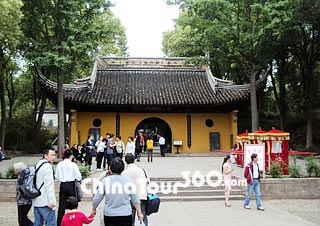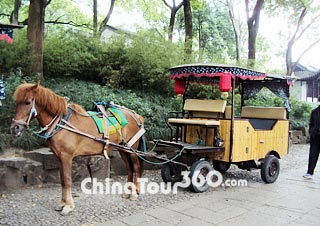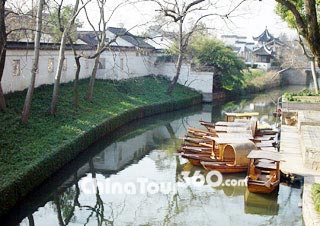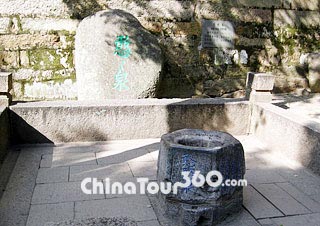 The Entrance of Tiger Hill
The Entrance of Tiger Hill A Carriage in Tiger Hill
A Carriage in Tiger Hill Suzhou Tiger Hill
Suzhou Tiger Hill Han Han Spring, Tiger Hill
Han Han Spring, Tiger Hill
Tiger Hill lies to the northwest of the old town of Suzhou. It is 34.3 meters (112.5 feet) above sea level, covering an area of 20 hectares (49.4 acres). It has long been known as 'the No.1 scenic spot in Wu', Wu being the ancient name for Suzhou. Su Shi, the famous Song Dynasty (960 - 1279) poet better known as Su Dongpo, a name he chose for himself (1037 - 1101), once said, 'It will be a pity if you come to Suzhou without visiting the Tiger Hill'.
Tiger Hill, also known as Haiyong Hill (the hill rising out of the sea), was said to be a small island in the sea thousands of years ago. Then after years of crustal movements, it rose above the sea and became an isolated hill. Even now, the traces of the sea can be seen on the round rocks eroded by waves. As for the origin of the name 'Tiger', there are two different versions. The first one is that Tiger Hill is the tomb of He Lü, the King of Wu in the Spring and Autumn Period (770 - 476 BC). It is said that for three days following his burial, a white tiger crouched on the hill, hence the name Tiger Hill. Another version is from a Song Dynasty professor Zhu Changwen and Emperor Qianlong of the Qing Dynasty (1644 - 1911), who believed that the hill was so named as it resembles a crouching tiger.
Although it is a small hill, there are a lot of historical spots on it, such as the Tiger Hill Tower, Sword Pond, Luyu Well, Lengxiang Pavilion and Hanhan Spring.
![]() Tiger Hill Tower
Tiger Hill Tower
The original tower, also called Yuyansi Tower, built in 601 was a timber construction. The current brick tower was built in 959. Since the Ming Dynasty (1368 - 1644), the tower began to lean to the northwest due to the poorly laid foundation. The tower leans at an angle of 2.48 degrees, so it is called 'the Oriental Leaning Tower of Pisa'. This unusual feature has resulted in the Tiger Hill Tower becoming a landmark building of the old town of Suzhou.
![]() Sword Pond
Sword Pond
Revered as the fifth Spring on Earth in the Tang Dynasty (618 - 907), Sword Pond is the most attractive and mysterious site on Tiger Hill. Set between two steep cliffs rising from the ground, the pond has sword-like shape as it is wide in the south and narrow in the north. When sunshine slants down onto the pond, the water gleams with a cold light which may make you feel cold even in hot summer. The perennial water in the pond is about 7.3 yards in depth and is clean and drinkable. It's said that it was the tomb area of He Lü, King of the Wu State in the Spring and Autumn Period. It was named sword pond because many of He Lü’s favorite swords were also buried in the tomb as sacrificial objects. Record has it that large amount of mercury was placed in the tomb to deter thieves. Therefore, the Sword Pond may have been created to cover the tomb of He Lü.
![]() Luyu Well
Luyu Well
There is a well on the hill, which is said to have been sunk by Lu Yu during the Tang Dynasty. It is recorded that Lu Yu lived on Tiger Hill for a long time. He was the author of the Book of Tea - the first to be written in China on the subject of tea, as result of his studies about this wonderful beverage. Lu Yu also found the water in the well was very sweet, so he awarded it the Third Well under Heaven.
Apart from the famous sites, Tiger Hill is also reputed for its cliff-side inscriptions. The most well-known are the four characters inscribed to the west of Erxian Pavilion. The four big characters 'Hu Qiu Jian Chi' (Tiger Hill and Sword Pond) was written by Yan Zhenqin (709 - 785), an eminent Tang Dynasty calligrapher. Other important attractions here include flower shows during spring, when tons of flowers will be displayed, such as peonies, tulips, rhododendrons, and lilies; and traditional fairs each autumn. These events will help you learn more about the traditional Wu Culture.
![]() Entrance Fee:
Entrance Fee:
CNY 60 (Apr. 16th to Oct. 30th)
CNY 40 (Oct. 31st to Apr. 15th)
![]() Opening Hours: 07:30 - 18:00
Opening Hours: 07:30 - 18:00
![]() Transportation:
Transportation:
A. Take Bus No. 949, 146, 316, or Tourism Bus No. 1, 2, or 3 from Suzhou City, which can take you to the south gate of Tiger Hill directly.
B. Take Bus No. 32 or 36 from Suzhou City to the north gate of Tiger Hill.







